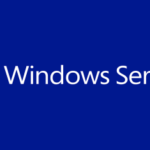Today we install Windows Server 2016 Édition standard. This installation in the future will host SCCM SQL. I make some preparation – download Windows Server 2016 *.ISO et créez un "Virtual Machine» (VM).
1. Start VM and press Espace Quand le message Press any key to boot from CD or DVD appears;

2. Définissez votre Langue, Format de devise, and Keyboard. Click the Suivant bouton;

3. Cliquez Installer (Nous n'avons pas besoin de réparer);
4. Select your Edition et Type de déploiement.
Si vous choisissez l'option d'installation du serveur
Avec cette option, L'interface utilisateur standard (le «serveur graphique Coquille") n'est pas installé; you manage the server using the command line, Windows PowerShell, ou par méthodes distantes.
- Interface utilisateur: invite de commande (Server Graphical Shell is not installed)
- Installer, configure, et désinstaller des rôles de serveur localement: at a command prompt with Windows PowerShell.
- Installer, configure, et désinstaller des rôles de serveur à distance: avec le gestionnaire de serveur, Outils d'administration du serveur distant (RSAT), or Windows PowerShell. Note For RSAT, you must use the Windows 8 version.
- Console de gestion Microsoft: non disponible localement.
- Expérience de bureau: pas disponible.
- Rôles de serveur disponibles:
- Active Directory Certificate Services
- Services de domaine Active Directory
- Dhcp Serveur
- DNS Serveur
- Services de fichiers (y compris le gestionnaire de ressources de serveur de fichiers)
- Active Directory Lightweight Directory Services (Publicité)
- Hyper-v
- Services d'impression et de documentation
- Streaming Media Services
- Serveur Web (y compris un sous-ensemble d'Asp.net)
- Windows Server Update Server
- Active Directory Rights Management Server
- Serveur de routage et d'accès à distance et les sous-rôles suivants:
- Courtier de connexion des services à distance de bureau
- Licence
- Virtualisation
Si vous choisissez le serveur avec une option GUI
Avec cette option, L'interface utilisateur standard et tous les outils sont installés. Les rôles et fonctionnalités de serveur sont installés avec Server Manager ou par d'autres méthodes.
- Interface utilisateur: Interface utilisateur graphique standard («Shell graphique du serveur»). The Server Graphical Shell includes the new Windows 8 shell but does not include the Windows Store or support for Windows Store apps. To enable support for the Windows Store and Windows Store apps, Installez la fonction d'expérience de bureau.
- Installer, configure, et désinstaller des rôles de serveur localement: with Server Manager or with Windows PowerShell Installer, configure, et désinstaller des rôles de serveur à distance: avec le gestionnaire de serveur, Serveur distant, RSAT, or Windows PowerShell
- Console de gestion Microsoft: installé
- Expérience de bureau: installable with Server Manager or Windows PowerShell
- To convert to a Server Core installation with Windows PowerShell: Exécutez la cmdlet suivante: Uninstall-windowsFeature Server-Gui-Mgmt-infra -restart
If you initially install with the Server with a GUI option and then use the above command to convert to a Server Core installation, you can later revert to a Server with a GUI installation without specifying a source. En effet, les fichiers nécessaires restent stockés sur le disque, même s'ils ne sont plus installés. Pour plus d'informations, and for instructions to completely remove the Server with GUI files from the disk, Voir la section «fonctionnalités sur demande» de ce document.
Si vous vous convertissez en installation de base du serveur, Windows features, rôles de serveur, and GUI management tools that require a Server with a GUI installation will be uninstalled automatically. You can specify the -WhatIf option in Windows PowerShell to see exactly which features will be affected by the conversion.
Je sélectionne Serveur Windows 2016 Standard (Expérience de bureau).
NOTE: There is no 32-bit Windows Server 2016, Seulement l'architecture 64 bits.
Après avoir sélectionné Click Suivant bouton;

5. Lire et définir la coche à J'accepte les conditions de licence et cliquez sur le Suivant bouton;
6. Sélectionner Coutume: Install Windows only (avancé);

7. Sélectionnez le disque cible et cliquez sur le Suivant bouton;

8. L'installation commence;
9. Une fois l'installation terminée, vous recevez un message sur le redémarrage, Cliquez sur le bouton Redémarrer maintenant ou attendre (Le système se redémarre);
10. Enter the password for the built-in user Administrateur et cliquez sur le Finition bouton;
11. Système installé et vous pouvez vous connecter (Ctrl+Alt+Supprimer);




















